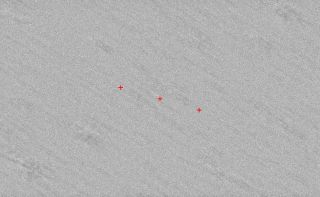
The area in the sky where astronomers would
have spotted the asteroid 2006 QV89 if it was on a collision course with
Earth, with the three crosses marking the specific locations.
(Image: © ESO)
A potentially hazardous asteroid that had a small chance of smashing into Earth this September isn't heading for our planet after all.
Astronomers ruled out the asteroid's chance of impact with Earth after they were not able to spot it within the area of its predicted collision course, making it the first time an asteroid impact was ruled out based on "non-detection."
The asteroid, named 2006 QV89, was discovered on Aug. 29, 2006 by the Catalina Sky Survey near Tucson, Arizona. It measures between 70 to 160 feet (20 to 50 meters) in diameter, or somewhere between the length of a bowling alley and the width of a football field. Observations suggested that it had a one-in-7,000 chance of impacting Earth on Sept. 9, 2019.
Related: Potentially Dangerous Asteroids (Images)
Astronomers ruled out the asteroid's chance of impact with Earth after they were not able to spot it within the area of its predicted collision course, making it the first time an asteroid impact was ruled out based on "non-detection."
The asteroid, named 2006 QV89, was discovered on Aug. 29, 2006 by the Catalina Sky Survey near Tucson, Arizona. It measures between 70 to 160 feet (20 to 50 meters) in diameter, or somewhere between the length of a bowling alley and the width of a football field. Observations suggested that it had a one-in-7,000 chance of impacting Earth on Sept. 9, 2019.
Related: Potentially Dangerous Asteroids (Images)
CLOSE
After
its discovery in 2016, the asteroid was observed for 10 days before
disappearing from the astronomers' sight, according to a statement by
the European Southern Observatory (ESO). As the date for the potential
collision approached, astronomers could only predict the location of the
asteroid with very low accuracy, which made it difficult to locate with
a telescope.
In order to confirm whether or not the asteroid was still headed for collision with Earth, astronomers at the European Space Agency (ESA) and ESO took a different approach. Rather than trying to observe the asteroid itself, astronomers observed where it should have been if it were, in fact, heading toward Earth.
Using ESO's Very Large Telescope (VLT), they captured deep images of the area where it would have been if it were on track to collide with our planet, ESO officials said in the statement. Following observations of the area on July 4-5, astronomers could not find the asteroid and therefore concluded that it would not be impacting Earth.
Even if the asteroid is smaller than initially believed, it would have been spotted by the telescope, ESO said in the statement. And if it were any smaller than that — too small for the telescope to detect — it would pose no threat to Earth, as it would burn up in the planet's atmosphere.
In order to confirm whether or not the asteroid was still headed for collision with Earth, astronomers at the European Space Agency (ESA) and ESO took a different approach. Rather than trying to observe the asteroid itself, astronomers observed where it should have been if it were, in fact, heading toward Earth.
Using ESO's Very Large Telescope (VLT), they captured deep images of the area where it would have been if it were on track to collide with our planet, ESO officials said in the statement. Following observations of the area on July 4-5, astronomers could not find the asteroid and therefore concluded that it would not be impacting Earth.
Even if the asteroid is smaller than initially believed, it would have been spotted by the telescope, ESO said in the statement. And if it were any smaller than that — too small for the telescope to detect — it would pose no threat to Earth, as it would burn up in the planet's atmosphere.
- Astronomers Spotted a Car-Size Asteroid Just Hours Before Impact
- New Look at 111-Year-Old Asteroid Hit Provides Clues to Future Impacts
- How Earth Life Could Come Back from a Sterilizing Asteroid Impact
Have a news tip, correction or comment? Let us know at community@space.com.












